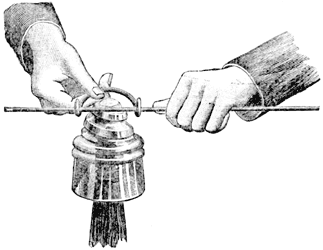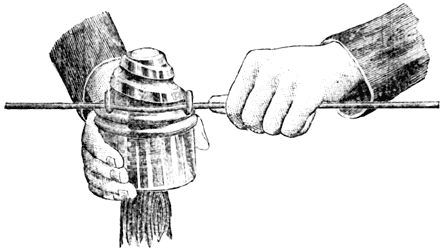[Trade Journal]
Publication: The Electrician & Electrical Engineer
New York, NY, United States
vol. 4, no. 5, p. 164, col. 1-2
THE NATIONAL SELF-BINDING INSULATOR.
THIS insulator, which is now being placed upon the market, embodies certain new features which appear to be of greater practical value than any improvement made in glass insulators since the introduction of the internal screw-thread, now almost universally used in this country. This improvement enables the ordinary tie-wire to be wholly dispensed with, the insulator, with its clip, being so formed that the line-wire is readily placed in position, and rigidly secured without the aid of tools. The insulator can be applied in any position, wherever the ordinary pattern is available.
 |
| Figure 1. |
Upon the exterior of the upper portion is formed a conical and gradually expanding screw-thread, similar in shape and principle to the point of a gimlet. By the use of a rigid wire shackle or clip the line-wire is attached as shown in figure 1. The clips are prepared ready for use as shown in figure 2, the main curve being so formed as to encircle the body of the insulator at the base of the conical screw, while each end is bent into a hook, which grasps the line-wire as shown. The bell of the insulator below the resting place of the line-wire is of a form which experience has shown to be the most desirable for insulating purposes. In attaching the line-wire, the insulator is first screwed a short distance upon the pin, and the point of the screw-top inserted within the clip, which has been previously hooked over the wire at the proper point, as shown in figure 2. The outside and inside threads being led in opposite directions, two or three turns of the insulator brings it to its bearing on the pin, at the same time carrying the clip with the wire into its proper position, as shown in figure 3. A little practice enables the lineman to do this work with the greatest ease and rapidity, while the attachment is perfect in appearance and security. This ingenious and effective device is the invention of J. Slater Lewis, of Birkenhead, England. It has been used in Europe and India for some time, where is has been highly approved, and pronounced to be the only insulator thoroughly adapted to the various requirements of telegraph construction. The principle English railways and telephone companies are now using it, and after rigid tests the officers of the British post-office telegraph have decided to adopt it exclusively for all future work. It may be mentioned that the internal screw of this insulator is more perfect than any heretofore made, by reason of the use of newly-invented molding tools (patented by L. B. Gray and J. Ham, October 7, 1884), which give greater sharpness and accuracy to the thread. Thus the insulator is not only held more securely to the pin, but is more readily attached, while the loss arising from the discarding of insulators which are defective in this respect is avoided. Various advantages of more or less importance are secured by the use of this insulator. A considerable saving in new construction may be effected, as after a little experience a considerably greater length of wire may be strung in a given time by the same number of hands than by the old method. In renewing line-wire on poles its superiority is still more apparent. In replacing broken insulators, changing poles, etc., no tolls of any description are required in order to transfer the wires. The discarded insulator can be unscrewed or broken to pieces in an instant, and the new one substituted without disturbing the clip or even ordinary tie-wire, if the later be used. Where a line has been constructed with this insulator no expense for new tie-wires will be incurred in re-building, nor time consumed in removing the old ones. The same clips may be used and removed repeatedly without damage.
 |
| Figure 2. |
One of the most important points to be gained by its use is the greater durability of the line-wire, which is due to the fact that as no tools are used in making the attachment, the zinc coating of the wire is not abraded. Mechanical injuries of this nature permit the access of moisture; the iron or steel is attacked by rust, resulting in weakness and ultimate breakage. Better insulation is also secured, as there are fewer crevices to facilitate the accumulation of soot and dust, while those which do exist are open to the cleansing action of rain. By proper adaptation of the length of the clip, the wire may be held at any required degree of tightness.
 |
| Figure 3. |
The old tie-wire fastening may be used in connection with this insulator, as with the ordinary pattern. Used in this manner, it is equal in every respect to the old form, retaining, however, the important advantage of replacement, with less than half the time and labor. In order to meet every possible requirement in either building or rebuilding, these insulators are now being made in the same standard sizes as have been generally used heretofore.
